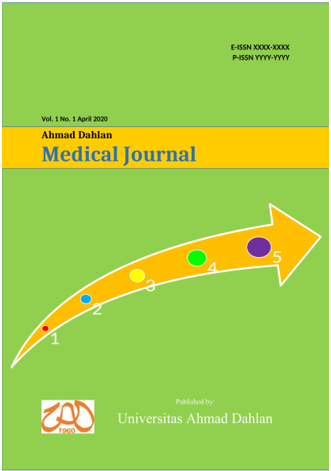Gaucher’s Disease : A Case Report
Keywords:
Gaucher disease; Genetic disorder; Glucocerebrosidase; Literature ReviewAbstract
Gaucher disease is a rare genetic disorder in which a person lacks an enzyme called glucocerebrosidase (GBA). Gaucher disease is an autosomal recessive inherited disorder of metabolism where a type of fat (lipid) called glucocerebroside cannot be adequately degraded. The lack of the GBA causes harmful substances to build up in the lung, liver, spleen, bones, and bone marrow, brain and eyes. These substances prevent cells and organs from working properly. There are three recognized Types of Gaucher disease and each has a wide range of symptoms. Type 1 is the most common, does not affect the nervous system and may appear early in life or adulthood. Many people with Type 1 Gaucher disease have findings that are so mild that they never have any problems from the disorder. Type 2 and 3 do affect the nervous system. A man, 27th, goes to the hospital with pain at upper of left knee, swollen since 3 week ago, hypertension(-), DM (-), history of left knee operation. Traumatic history (-). HB: 14,9mmgr/dl, AL 7,6. AT 186, HMT 43,8%, GDS 95 mg/dl, APTT 34,4. PPT: 11,6, diff eosinophil: 3,2. From the symptoms dan clinical finding from this patient we can make conclusion, the case is typical Gaucher disease type 1.
References
Futerman AH, Zimran A. Gaucher Disease. Hum Genet. 2007;121(5). doi:10.1007/s00439-007-
-x
Kartha R V., Terluk MR, Brown R, et al. Patients with Gaucher disease display systemic oxidative
stress dependent on therapy status. Mol Genet Metab Rep. 2020;25(October):100667.
doi:10.1016/j.ymgmr.2020.100667
Kuhn AS, Makusha LP, Bokhari SAJ. Symmetric, bilateral upper and lower extremity lucent
lesions in a patient with Gaucher’s disease on enzyme replacement therapy. Radiol Case Rep.
;15(11):2067-2070. doi:10.1016/j.radcr.2020.08.032
Oliveri B, González DC, Ferrari E. Bone symptoms can be an early manifestation of Gaucher
disease implications for diagnosis. Endocrine and Metabolic Science. 2020;1(1-2):100050.
doi:10.1016/j.endmts.2020.100050
Cassinerio E, Graziadei G, Poggiali E. Gaucher disease: A diagnostic challenge for internists. Eur J
Intern Med. 2014;25(2):117-124. doi:10.1016/j.ejim.2013.09.006
Stirnemann JÔ, Belmatoug N, Camou F, et al. A review of gaucher disease pathophysiology,
clinical presentation and treatments. Int J Mol Sci. 2017;18(2). doi:10.3390/ijms18020441
Mignot C, Doummar D, Maire I, et al. Type 2 Gaucher disease: 15 New cases and review of the
literature. Brain Dev. 2006;28(1):39-48. doi:10.1016/j.braindev.2005.04.005
Weiss K, Gonzalez AN, Lopez G, Pedoeim L, Groden C, Sidransky E. The clinical management of
type 2 Gaucher disease. Mol Genet Metab. 2015;114(2):110-122. doi:10.1016/j.ymgme.2014.11.008
Sam R, Chen Y, Tayebi N, Sidransky E. Generating pluripotent stem-cell derived organoids to
model Gaucher disease type 2. Mol Genet Metab. 2021;132(2):S94.
doi:10.1016/j.ymgme.2020.12.226
Charkhand B, Scantlebury MH, Narita A, Zimran A, Al-Hertani W. Effect of Ambroxol chaperone
therapy on Glucosylsphingosine (Lyso-Gb1) levels in two Canadian patients with type 3 Gaucher
disease. Mol Genet Metab Rep. 2019;20(February):100476. doi:10.1016/j.ymgmr.2019.100476
Oguri M, Saito Y, Okanishi T, et al. High-frequency component in flash visual evoked potentials in
type 3 Gaucher disease. Brain Dev. 2020;42(1):19-27. doi:10.1016/j.braindev.2019.08.005
Nguyen Y, Stirnemann J, Belmatoug N. Gaucher disease. Rev Prat. 2020;70(4):416-420.
doi:10.1016/B978-0-444-59565-2.00040-X.Review.
Stirnemann JÔ, Belmatoug N, Camou F, et al. A review of gaucher disease pathophysiology,
clinical presentation and treatments. Int J Mol Sci. 2017;18(2). doi:10.3390/ijms18020441
Dumitrascu DL. Gaucher disease: an update. Med Pharm Rep. 2021;94(Suppl No 1):S54-S56.
doi:10.15386/mpr-2231
Vancauwenberghe T, Snoeckx A, Vanbeckevoort D, Dymarkowski S, Vanhoenacker FM. Imaging
of the spleen: what the clinician needs to know. Singapore Med J. 2015;56(3):133-144.
doi:10.11622/smedj.2015040
Dineen-Griffin S, Garcia-Cardenas V, Williams K, Benrimoj SI. Helping patients help themselves:
A systematic review of self-management support strategies in primary health care practice. PLoS
One. 2019;14(8). doi:10.1371/journal.pone.0220116
Margaret O, Riley. Understanding Gaucher Disease - Vancouver Coastal Health.
Downloads
Published
How to Cite
Issue
Section
License
Copyright (c) 2023 Elvina Prisila

This work is licensed under a Creative Commons Attribution-ShareAlike 4.0 International License.
License and Copyright Agreement
In submitting the manuscript to the journal, the authors certify that:
- They are authorized by their co-authors to enter into these arrangements.
- The work described has not been formally published before, except in the form of an abstract or as part of a published lecture, review, thesis, or overlay journal. Please also carefully read Ahmad Dahlan Medical Journal posting Your Article Policy.
- That it is not under consideration for publication elsewhere.
- That its publication has been approved by all the author(s) and by the responsible authorities - tacitly or explicitly - of the institutes where the work has been carried out.
- They secure the right to reproduce any material that has already been published or copyrighted elsewhere.
- They agree to the following license and copyright agreement.
Copyright
Authors who publish with Ahmad Dahlan Medical Journal agree to the following terms:
- Authors retain copyright and grant the journal right of first publication with the work simultaneously licensed under a Creative Commons Attribution License (CC BY-SA 4.0) that allows others to share the work with an acknowledgment of the work's authorship and initial publication in this journal.
- Authors are able to enter into separate, additional contractual arrangements for the non-exclusive distribution of the journal's published version of the work (e.g., post it to an institutional repository or publish it in a book), with an acknowledgment of its initial publication in this journal.
- Authors are permitted and encouraged to post their work online (e.g., in institutional repositories or on their website) prior to and during the submission process, as it can lead to productive exchanges, as well as earlier and greater citation of published work.


